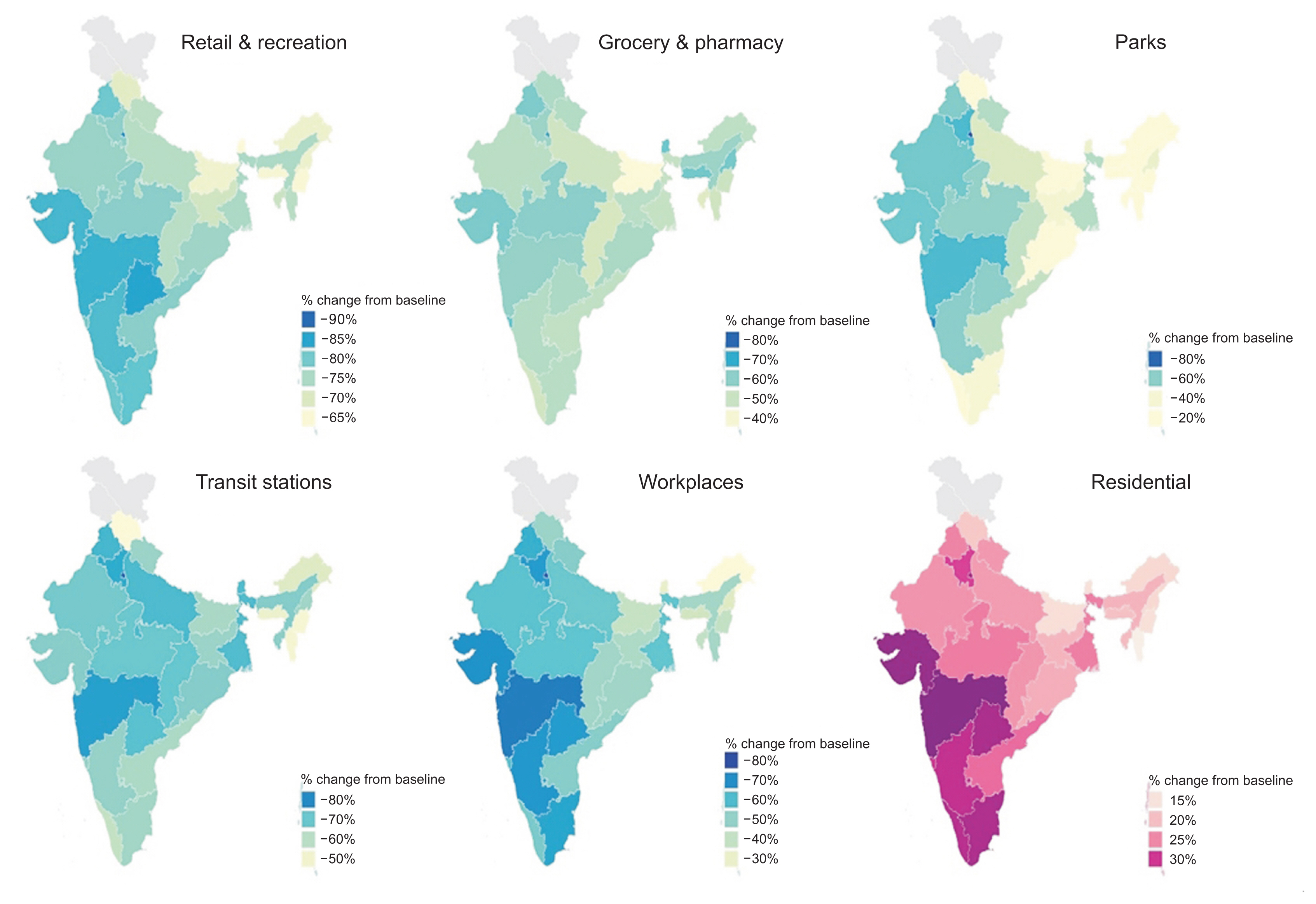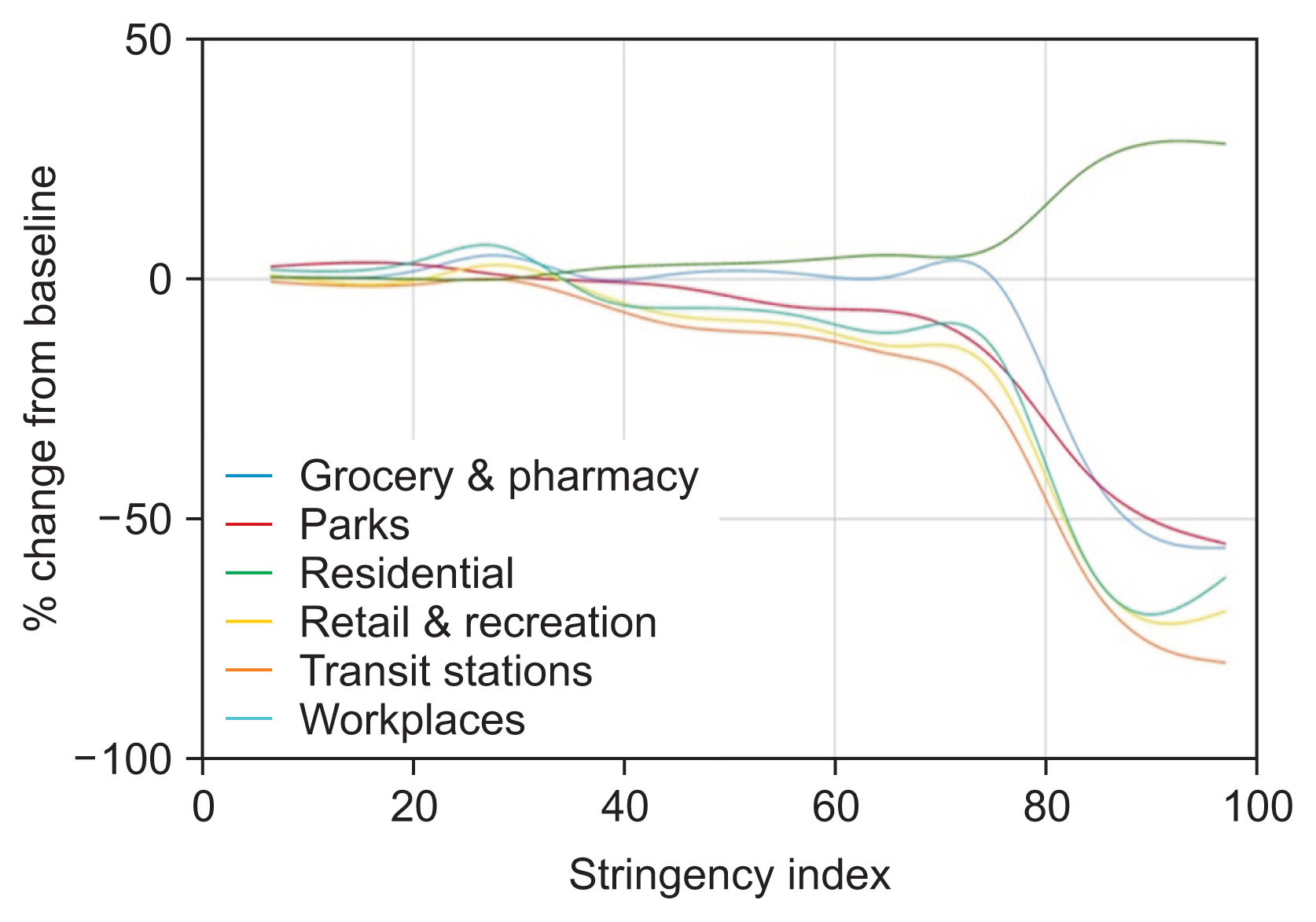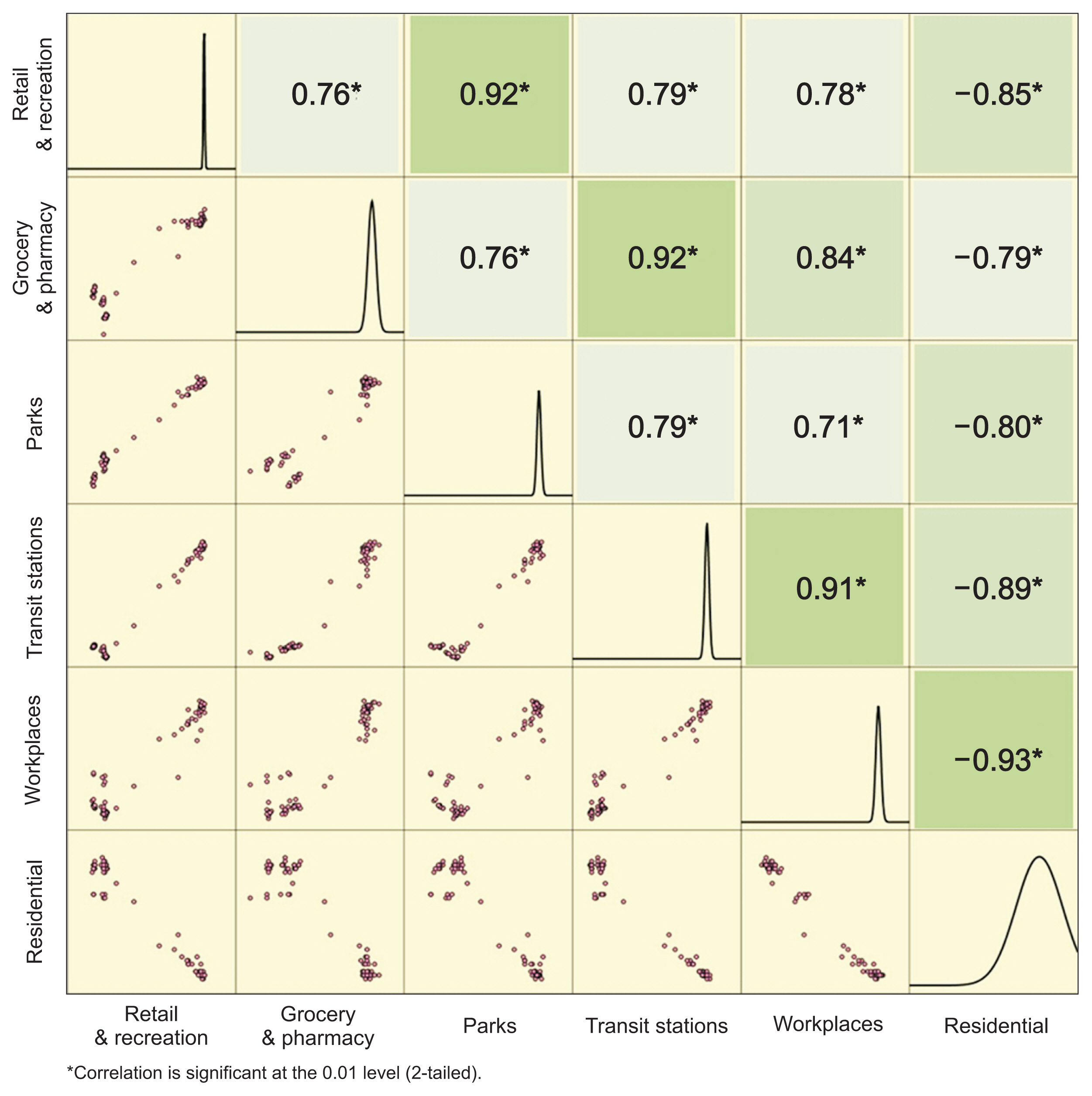Healthc Inform Res.
2021 Oct;27(4):325-334. 10.4258/hir.2021.27.4.325.
Population Mobility, Lockdowns, and COVID-19 Control: An Analysis Based on Google Location Data and Doubling Time from India
- Affiliations
-
- 1Department of Community Medicine, School of Public Health, Postgraduate Institute of Medical Education and Research, Chandigarh, India
- 2Department of Community Medicine, Vardhman Mahavir Medical College and Safdarjung Hospital, New Delhi, India
- KMID: 2522214
- DOI: http://doi.org/10.4258/hir.2021.27.4.325
Abstract
Objectives
Physical distancing is a control measure against coronavirus disease 2019 (COVID-19). Lockdowns are a strategy to enforce physical distancing in urban areas, but they are drastic measures. Therefore, we assessed the effectiveness of the lockdown measures taken in the world’s second-most populous country, India, by exploring their relationship with community mobility patterns and the doubling time of COVID-19.
Methods
We conducted a retrospective analysis based on community mobility patterns, the stringency index of lockdown measures, and the doubling time of COVID-19 cases in India between February 15 and April 26, 2020. Pearson correlation coefficients were calculated between the stringency index, community mobility patterns, and the doubling time of COVID-19 cases. Multiple linear regression was applied to predict the doubling time of COVID-19.
Results
Community mobility drastically fell after the lockdown was instituted. The doubling time of COVID-19 cases was negatively correlated with population mobility patterns in outdoor areas (r = –0.45 to –0.58). The stringency index and outdoor mobility patterns were also negatively correlated (r = –0.89 to –0.95). Population mobility patterns (R2 = 0.67) were found to predict the doubling time of COVID-19, and the model’s predictive power increased when the stringency index was also added (R2 = 0.73).
Conclusions
Lockdown measures could effectively ensure physical distancing and reduce short-term case spikes in India. Therefore, lockdown measures may be considered for tailored implementation on an intermittent basis, whenever COVID-19 cases are predicted to exceed the health care system’s capacity to manage.
Figure
Cited by 1 articles
-
Lockdowns, Community Mobility Patterns, and COVID-19: A Retrospective Analysis of Data from 16 Countries
U Venkatesh, Aravind Gandhi P, Tasnim Ara, Md Mahabubur Rahman, Jugal Kishore
Healthc Inform Res. 2022;28(2):160-169. doi: 10.4258/hir.2022.28.2.160.
Reference
-
References
1. World Health Organization. Coronavirus disease (COVID-19) situation report [Internet]. Geneva, Switzerland: World Health Organization;2020. [cited at 2021 Oct 15]. Available from: https://www.who.int/docs/default-source/coronaviruse/situation-reports/20200921-weekly-epi-update-6.pdf?sfvrsn=d9cf9496_6 .2. Muniz-Rodriguez K, Chowell G, Cheung CH, Jia D, Lai PY, Lee Y, et al. Doubling time of the COVID-19 epidemic by province, China. Emerg Infect Dis. 2020; 26(8):1912–4.
Article3. Worldometer. Coronavirus age, sex, demographics (COVID-19) [Internet]. [place unknown]: Worldometer;2020. [cited at 2021 Oct 15]. Available from: https://www.worldometers.info/coronavirus/coronavirus-age-sex-demographics/ .4. World Health Organization. COVID-19: Infection prevention and control / WASH [Internet]. Geneva, Switzerland: World Health Organization;2020. [cited at 2021 Oct 15]. Available from: https://www.who.int/emergencies/diseases/novel-coronavirus-2019/technical-guidance-publications?publicationtypes=d198f134-5eed-400d-922e-1ac06462e676 .5. The Lancet. India under COVID-19 lockdown. Lancet. 2020; 395(10233):1315.6. Carrasco-Escobar G, Castro MC, Barboza JL, Ruiz-Cabrejos J, Llanos-Cuentas A, Vinetz JM, et al. Use of open mobile mapping tool to assess human mobility traceability in rural offline populations with contrasting malaria dynamics. PeerJ. 2019; 7:e6298.
Article7. Ruktanonchai NW, Ruktanonchai CW, Floyd JR, Tatem AJ. Using Google Location History data to quantify finescale human mobility. Int J Health Geogr. 2018; 17(1):28.
Article8. Webb L. COVID-19 lockdown: a perfect storm for older people's mental health. J Psychiatr Ment Health Nurs. 2021; 28(2):300.
Article9. Riley T, Sully E, Ahmed Z, Biddlecom A. Estimates of the potential impact of the COVID-19 pandemic on sexual and reproductive health in low- and middle-income countries. Int Perspect Sex Reprod Health. 2020; 46:73–6.10. Ngonghala CN, Iboi E, Eikenberry S, Scotch M, MacIntyre CR, Bonds MH, et al. Mathematical assessment of the impact of non-pharmaceutical interventions on curtailing the 2019 novel Coronavirus. Math Biosci. 2020; 325:108364.
Article11. Lai S, Ruktanonchai NW, Zhou L, Prosper O, Luo W, Floyd JR, et al. Effect of non-pharmaceutical interventions to contain COVID-19 in China. Nature. 2020; 585(7825):410–3.
Article12. Chatterjee K, Chatterjee K, Kumar A, Shankar S. Healthcare impact of COVID-19 epidemic in India: a stochastic mathematical model. Med J Armed Forces India. 2020; 76(2):147–55.
Article13. Lu N, Cheng KW, Qamar N, Huang KC, Johnson JA. Weathering COVID-19 storm: Successful control measures of five Asian countries. Am J Infect Control. 2020; 48(7):851–2.
Article14. Know India. States and union territories [Internet]. New Delhi, India: Know India;c2020. [cited at 2021 Oct 15]. Available from: https://knowindia.india.gov.in/states-uts/ .15. Pulla P. Covid-19: India imposes lockdown for 21 days and cases rise. BMJ. 2020; 368:m1251.
Article16. World Health Organization. SARS-CoV-2 variants [Internet]. Geneva, Switzerland: World Health Organization;[cited at 2021 Oct 15]. Available from: https://www.who.int/emergencies/disease-outbreak-news/item/2020-DON305 .17. Callaway E. The coronavirus is mutating: does it matter? Nature. 2020; 585(7824):174–7.18. Google. COVID-19 community mobility report [Internet]. Mountain View (CA): Google;2020. [cited at 2021 Oct 15]. Available from: https://www.google.com/covid19/mobility .19. Hale T, Petherick A, Phillips T, Webster S. Variation in government responses to COVID-19[Internet]. Oxford UK: Blavatnik School of Government;2020. [cited at 2021 Oct 15]. Available from: https://www.bsg.ox.ac.uk/sites/default/files/2020-04/BSG-WP-2020-032-v5.0.pdf .20. Galvani AP, Lei X, Jewell NP. Severe acute respiratory syndrome: temporal stability and geographic variation in case-fatality rates and doubling times. Emerg Infect Dis. 2003; 9(8):991–4.
Article21. Wallinga J, Lipsitch M. How generation intervals shape the relationship between growth rates and reproductive numbers. Proc Biol Sci. 2007; 274(1609):599–604.
Article22. EViews [Internet]. Irvine (CA): IHS Global Inc;2020. [cited at 2021 Oct 15]. Available from: https://www.eviews.com/home.html .23. Evans WN. Time Series Analysis: Durbin-Watson significance tables [Internet]. Notre Dame (IN): University of Notre Dame;2018. [cited at 2021 Oct 15]. Available from: https://www3.nd.edu/~wevans1/econ30331/Durbin_Watson_tables.pdf .24. Ferguson NM, Laydon D, Nedjati-Gilani G, Imai N, Ainslie K, Baguelin M, et al. Report 9: Impact of non-pharmaceutical interventions (NPIs) to reduce COVID19 mortality and healthcare demand [Internet]. London, UK: Imperial College COVID-19 Response Team, Imperial College London;2020. [cited at 2021 Oct 15]. Available from: https://doi.org/10.25561/77482 .
Article25. Wesolowski A, Buckee CO, Engo-Monsen K, Metcalf CJ. Connecting mobility to infectious diseases: the promise and limits of mobile phone data. J Infect Dis. 2016; 214(suppl_4):S414–S420.
Article26. Sjodin H, Wilder-Smith A, Osman S, Farooq Z, Rocklov J. Only strict quarantine measures can curb the coronavirus disease (COVID-19) outbreak in Italy, 2020. Euro Surveill. 2020; 25(13):2000280.
Article27. Ruktanonchai NW, Floyd JR, Lai S, Ruktanonchai CW, Sadilek A, Rente-Lourenco P, et al. Assessing the impact of coordinated COVID-19 exit strategies across Europe. Science. 2020; 369(6510):1465–70.
Article28. Ji T, Chen HL, Xu J, Wu LN, Li JJ, Chen K, et al. Lockdown contained the spread of 2019 novel coronavirus disease in Huangshi City, China: early epidemiological findings. Clin Infect Dis. 2020; 71(6):1454–60.
Article29. Kong Q, Jin H, Sun Z, Kao Q, Chen J. Non-pharmaceutical intervention strategies for outbreak of COVID-19 in Hangzhou, China. Public Health. 2020; 182:185–6.
Article30. Statista. Market share of mobile operating systems in India from 2012–2020 [Internet]. Arlington (VA): The Institute for Statistics Education;c2021. [cited at 2021 Oct 15]. Available from: https://www.statista.com/statistics/262157/market-share-held-by-mobile-operating-systems-in-india/ .
- Full Text Links
- Actions
-
Cited
- CITED
-
- Close
- Share
- Similar articles
-
- Lockdowns, Community Mobility Patterns, and COVID-19: A Retrospective Analysis of Data from 16 Countries
- Prediction of COVID-19 Outbreaks Using Google Trends in India: A Retrospective Analysis
- Impact of Government Healthcare Policy Changes on Consumption and Human Movements During COVID-19: An Interrupted Time Series Analysis in Korea
- Direct indicators of social distancing effectiveness in COVID-19 outbreak stages: a correlational analysis of case contacts and population mobility in Korea
- The Effectiveness of Community-based Social Distancing for Mitigating the Spread of the COVID-19 Pandemic in Turkey









